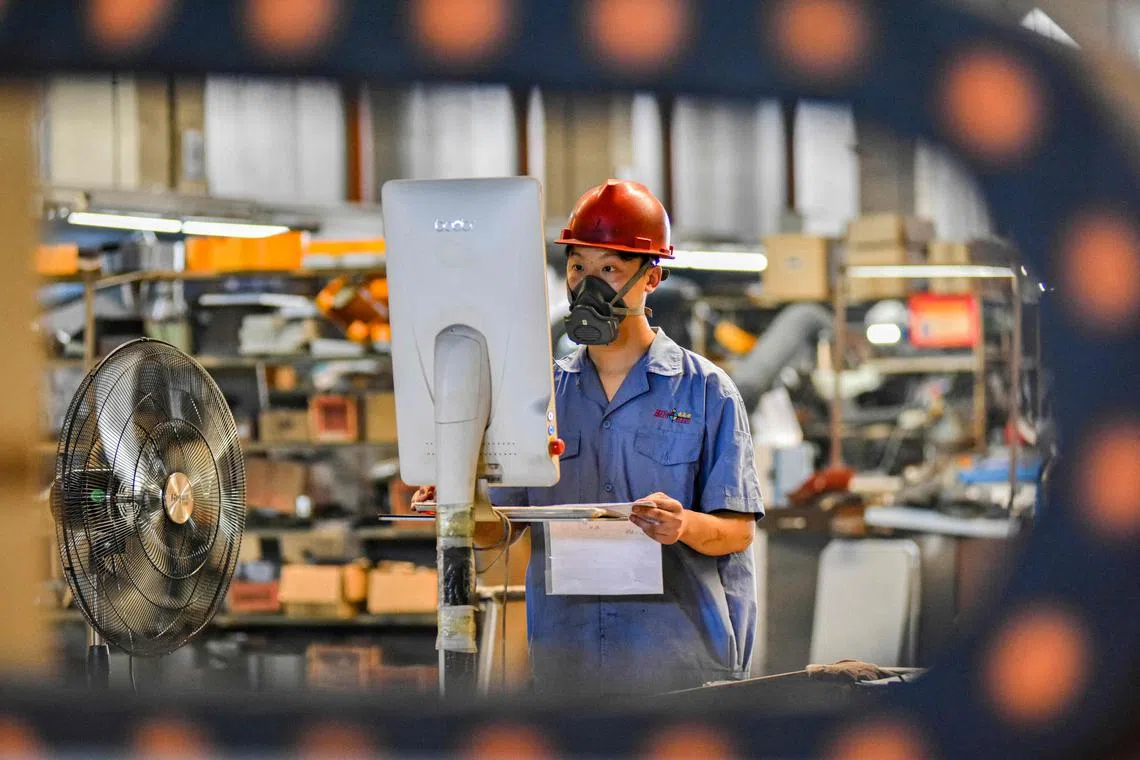China’s economy fails to pick up after worst stretch in five quarters
Sign up now: Get ST's newsletters delivered to your inbox

The latest snapshot of China’s economy shows that domestic demand is barely benefiting from recent efforts to boost consumption and rectify imbalances in its recovery.
PHOTO: AFP
Follow topic:
BEIJING – China’s economy has failed to pick up after its worst stretch in five quarters as sluggish confidence weighs on consumption and investment, putting the government’s annual growth target at risk.
Fixed-asset investment unexpectedly slowed to 3.6 per cent in the first seven months of 2024, while consumption remained weak despite a seasonal uptick in July. Capital spending by state-owned enterprises dropped to 6.3 per cent in the first seven months from 6.8 per cent in the first half, while that of private firms stagnated from a year ago.
Infrastructure investment has been one of the major engines of domestic demand, which has been trailing manufacturing in 2024, said Mr David Qu of Bloomberg Economics, adding that the expected slowdown there posed a warning sign.
“That means an engine of China’s economy on the demand side is also moderating and losing steam,” he said. “It tells us that maybe one day, the weakness in the demand side will return to bite the other side.”
The latest snapshot of China’s economy shows that domestic demand is barely benefiting from recent government efforts
Industrial output rose 5.1 per cent in July from a year ago, the National Bureau of Statistics (NBS) said on Aug 15, down from June’s increase of 5.3 per cent. The urban jobless rate reached 5.2 per cent, likely reflecting a wave of graduates entering the summer market.
While retail sales climbed 2.7 per cent in July, slightly better than forecast, they likely benefited from a more favourable base of comparison and the summer holiday season, according to Ms Serena Zhou, senior China economist at Mizuho Securities Asia.
“We believe the economy faces a significant threat from self-fulfilling deflation expectations,” she added. “The government’s top priority should be to break this downward spiral early with more assertive measures.”
Long-term relief for the consumer is unlikely, so long as China’s real estate slump squeezes household budgets. Though the government rolled out its biggest rescue package for the property sector in May, it has yet to help the market bottom out quicker.
“The economy’s momentum slowed,” said Mr Ding Shuang, chief economist for Greater China and North Asia at Standard Chartered Bank. “This has posed more challenges to the goal of achieving around 5 per cent growth this year, and policymakers would see this too.”
The economy was “overall stable” in July with some improvement, the NBS said in a statement. “There’s an increasing negative impact from the changing external environment, while domestic demand remains insufficient. The switch from old to new growth drivers is causing temporary pains.”
An absence of a meaningful recovery in the economy is likely to amplify calls for additional policy stimulus as Beijing chases its annual growth target of around 5 per cent. China’s top leaders already signalled a more supportive stance towards growth at a recent Politburo meeting by vowing to shift their focus to consumption, though the broad pledges have been met with scepticism in the market.
Figures released earlier in August already provided evidence of a weak start to the third quarter. China’s export growth unexpectedly slowed in July as overseas orders began to soften, while the country’s bank loans to the real economy contracted for the first time in 19 years.
The economy’s performance marked “a weak start” to the second half, said ANZ senior China strategist Xing Zhaopeng. “Demand side weakness remains stubborn.” BLOOMBERG

